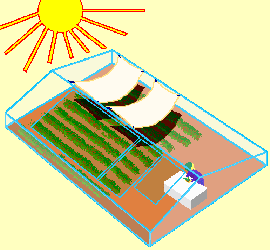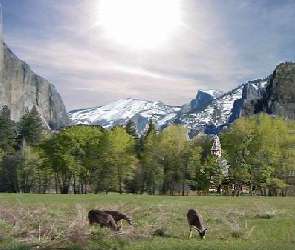|
|
 |
|
The greenhouse as a model of the lower atmosphere (troposphere)
With these experiments you can investigate if the colour of the ground has an impact on the greenhouse effect. Carry out the experiments in a room that is free of draught and with strong incident solar radiation.
Materials needed:
|
2 |
petri dishes of the same size (diameter ca. 100mm) |
|
2 |
measuring devices with temperature sensors that show the same temperature under the same conditions (choose accordingly!) |
|
1 |
white sheet of paper or cardboard of more than 100mm diameter |
|
1 |
black sheet of paper or cardboard of more than 100mm diameter |
|
1 |
heat insulating support (e.g. piece of wood) |
|
1 |
big piece of cardboard (or other material) for covering the petri dishes from the sun while you are setting up the experiment. |
|
1 |
clock with second hand |
While setting up the experiment no direct sunlight should reach both "greenhouses". Afterwards, during the experiment both "greenhouses" should be illuminated simultaneously and for the same amount of time. |
Set up the experiment according to Fig. 1.
Both petri dishes are placed with their bottoms upwards on top of the temperature sensor and the paper. The temperature sensors should touch neither the glass nor the paper but be in the middle of the head space.
|
E1
|
Illuminate both "greenhouses" simultaneously with sunlight.
Note down the temperature in the table below at regular time intervals. Find your own measuring intervals.
|
|
 |
 |
 |
|
Figure 1: Setup of the experiment on the greenhouse effect
© 2004 Seesing, Tausch Universität-Duisburg-Essen, Duisburg
|
|
|
Measuring results:
|
time in seconds |
0 |
|
|
|
|
|
|
|
|
|
|
|
|
|
temperature with white ground [°C] |
|
|
|
|
|
|
|
|
|
|
|
|
|
|
temperature with black ground [°C] |
|
|
|
|
|
|
|
|
|
|
|
|
| |
 |
 |
|
Figure 2: greenhouses a: with white, b: with black ground
© 2004 Seesing, Tausch Universität-Duisburg-Essen, Duisburg
|
|
 |
|
T1 |
Tick the correct answer:
The temperatures in the greenhouses a and b (Fig. 2) after continuous irradiation with sunlight is after a few hours
q the same
q in a higher than in b
q in a lower than in b | |
|
|
T2 |
Give reasons for your answer. Use the terms: "colour of the ground", "light" and "heat radiation". |
|
 |
 |
Figure 3: A greenhouse as model
© 2004 Seesing, Tausch Universität-Duisburg-Essen, Duisburg |
|
 |
 |
 |
Figure 4: Nature: "The real greenhouse"
© 2004 Seesing, Tausch Universität-Duisburg-Essen, Duisburg |
|
|
|
T3 |
In Fig. 3 you can see a greenhouse made of glass with three windows of different sizes in its roof. The proportions of the areas of the glass roof and the windows correspond to the proportions of the contribution of the four essential greenhouse gases to the greenhouse effect. Write the name of the greenhouse gas below the picture of the respective glass area that corresponds to the contribution of the gas to the greenhouse effect. | |
 |
 |
|
(scaled down) 1. _______________ 2. _______________ 3. _______________ 4. _______________
|
|
|
T4 |
The table shows several parts of the model of the greenhouse from Fig. 3. Complete the table by writing down which parts of nature they represent (in the second column) and naming their effect on light and heat radiation (in the third column). | |
|
|
symbole in the model of a greenhouse |
parts of nature |
effect on light and heat radiation |
|
sun
|

|
|
|
|
glass panes |

|
|
|
|
ground with plants and gardener
|

|
|
|
|
white curtains |

|
|
|
|
white table |

|
|
|
© 2004 Seesing, Tausch Universität-Duisburg-Essen, Duisburg
|
|
About this page:
Authors: M. Seesing, M. Tausch - Universität Duisburg-Essen, Duisburg / Germany
Reviewers:
Last update: 2004-05-13 |
|
 |
|









